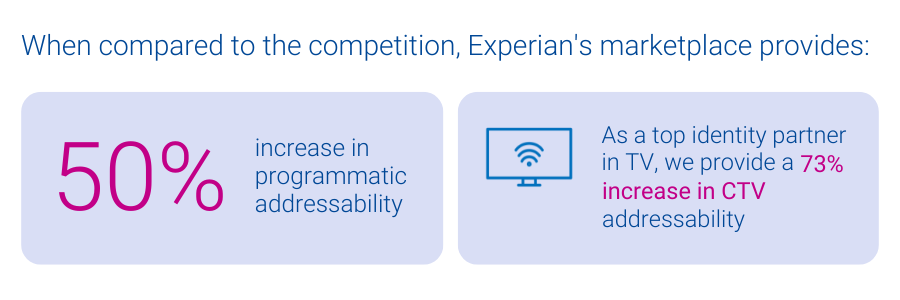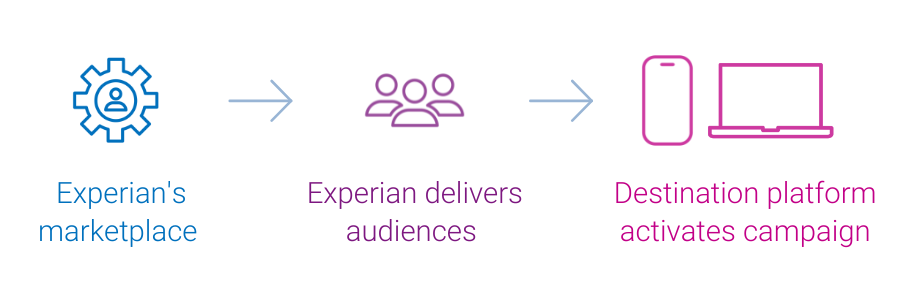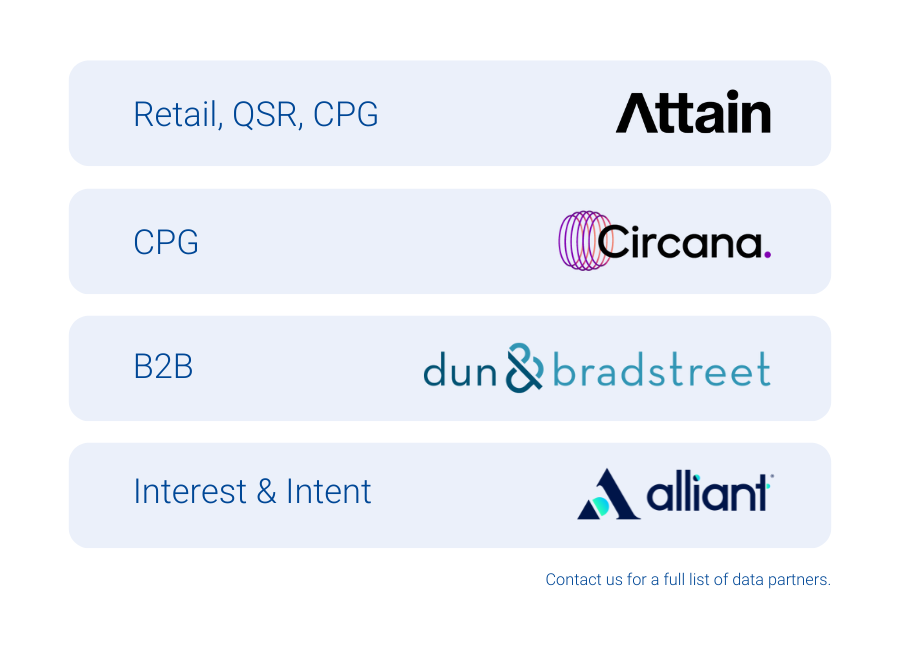
In a perfect world, we’d all have a single, go-to grocery store that carried everything on our shopping list – fresh produce, gourmet coffee beans, rare spices, and maybe even that special-grade olive oil, right alongside our wholesale bulk purchases at unbeatable prices. It would be convenient and efficient, and it’d save a lot of driving around town.
The changing data marketplace: From one-stop shop to specialized selection
For a long time, data buyers enjoyed something similar in their world: a small set of large-scale data marketplaces that offered a wide array of audiences, making it easy to load up on whatever you needed in one place. Not only are there fewer places to pick everything up, but new factors like privacy and signal deprecation are placing a spotlight on quality and addressability.
Just as our dinner plans are growing more ambitious insofar as we want health, flavor, value, and convenience all in one place – so are our data strategies. Instead of a single steak-and-potatoes meal, today’s data marketplace operators might be cooking up a complex menu of campaigns.
“Experian has been a longstanding partner of DISH Media, and we’re excited to be an early adopter of their marketplace which leverages the foundation of their identity solutions to ensure maximum cross-channel reach as we look to expand the breadth and depth of data we use for addressable TV.”
Kemal Bokhari, Head of Data, Measurement & Analytics, DISH Media
As a result, data buyers are beginning to shop around. Some still rely on large-scale marketplaces for familiar staples, but now they have reasons to explore other options. Some are turning to providers known for offering top-tier, transparently sourced segments. Others are focusing on specialty providers that excel in one area.
A more selective approach to data buying
In this environment, choosing where to “shop” for data is becoming more deliberate and selective. Data buyers aren’t just thinking about broad scale; they’re looking to prioritize quality, durability, data privacy, and differentiation. They need to place higher value on data marketplaces that can maintain audience addressability over time, despite signal loss. Sometimes, that means accepting a smaller assortment in exchange for tighter vetting and more reliable targeting. Other times it means mixing and matching – stopping by one marketplace for premium segments and another for cost-friendly, wide-reaching data sets. Either way, they can benefit from having more choices.
“Experian has been a longstanding partner of DISH Media, and we’re excited to be an early adopter of their marketplace which leverages the foundation of their identity solutions to ensure maximum cross-channel reach as we look to expand the breadth and depth of data we use for addressable TV.”
Kemal Bokhari, Head of Data, Measurement & Analytics, DISH Media
Experian’s marketplace: A trusted source for high-quality data
Experian’s vetted and curated blend of data partners and vertically-aligned audiences offers a trusted specialty store for data buyers. Experian’s marketplace, powered by identity graphs that include 126 million households, 250 million individuals, and 4 billion active digital IDs, enables partner audiences to be easily activated and maintain high addressability across display, mobile, and connected TV (CTV) channels. In particular, Experian’s marketplace provides:


The future of data marketplaces: Precision and flexibility matter
The evolution of data marketplaces reflects the industry’s shifting priorities. Data buyers seek specificity, reliability, and adaptability to align with their diverse campaign needs. The best data strategy, much like the best grocery run, isn’t about grabbing everything in one place – it’s about carefully selecting the right ingredients to create the perfect recipe for success. This shift underscores the importance of flexibility and precision as data buyers navigate a landscape shaped by privacy regulations, signal loss, and evolving consumer expectations.

As data marketplaces adapt to meet these demands, they are redefining what it means to deliver value. Experian’s marketplace enables buyers to strike the perfect balance between reach and quality by offering enhanced match rates, precise audience planning, and seamless distribution. In this new era, data buyers have the tools and options to craft campaigns that are impactful and aligned with the increasingly selective and privacy-conscious digital landscape. The key is recognizing that today’s data strategy is about utilizing the strengths of many to create a cohesive and effective whole.
If you’re interested in learning more about Experian’s marketplace or becoming an active buyer or seller in our marketplace, please contact us.
Latest posts

As marketers, we all want to better leverage data to understand our customer and provide them with the best possible experience. It not only better serves our clients, but is ultimately more profitable for the company. But most of us struggle with large volumes of data, with no idea how to best use it. There are many factors that play into this problem. For most organizations, data is spread out across multiple systems with no consistent data management strategy. That means that as marketers, when we get the data, it comes in a wide variety of forms. The standardization could be different, customers could be missing certain record fields, purchase history could be divided into different accounts…you get the picture. This disparity makes it difficult for us to get any sort of insight from the information. How can we leverage data if it is inaccurate, incomplete and not accessible? Experian Data Quality recently completed a survey of over 250 chief information officers (CIOs) and found that they too are struggling to leverage data. Four out of five see data as a valuable asset that is not being fully utilized within the organization. In speaking with the CIOs, some of the biggest challenges aren’t just about technology, but rather organizational structure and company culture. Sixty-eight percent of CIOs struggle to find stakeholders who take anything other than a siloed view of data management. In addition, 70 percent of respondents say they struggle to implement data-driven decision making because no one seems to own the process. To improve data insight, organizations need to improve the structure around data management. This is where the chief data officer (CDO) comes into play. The chief data officer is a growing c-suite position that is getting more and more popular. Most of the CIOs we spoke with that had a CDO said the role had only been created in the last six months. The reasons companies are looking to put a CDO in place are all related to improving access and insight from data. CDOs are there to: Reduce risk around data-driven projects Curb costs from poor quality data Handle increasing data governance pressures As this role continues to grow, it is going to have a big impact not only on marketing, but also the organization as a whole. With that in mind, join us for a webinar on Tuesday, August 18th at 2 PM EST to talk about the emergence of the chief data officer. We’ll discuss data as an untapped resource, how the role is changing organizations and how to ensure your organization is ready for the shift that this new role brings. Register today!

There is much to be said about the differences between college-age consumers (19- to 21-year-olds) today and their counterparts five years ago. As many marketers recognize, young-adult consumers cannot be targeted based solely on generalizations and assumptions. To accurately and respectfully capitalize on this segment’s buying power, marketers need to understand how their spending patterns have changed in recent years and how to earn a slice of the group’s spend. Accounting for inflation, 19- to 21-year-olds are making more money than young adults did five years ago. Their pay has increased by 20 percent, and, interestingly, their spending has increased by 30 percent. So where are they spending this money? 1. Dressing for success According to Census Area Projected Estimates (CAPE) of expenditure data from Experian Marketing Services, both men and women in this age group are filling their closets with about 35 percent more professional attire — shoes included. This has brought 2015’s average spend up to $22,859 per year per household for college-age women and $11,196 per household for college-age men. This rise in spending on professional wardrobe could be attributed to more professional entry-level job expectations or a possible shift in technical trade positions to business professional positions. CAPE data also reveals a 70 percent increase in memberships to networking and recreational clubs. This increasingly professional outlook among college age consumers requires confidence and the right ensemble to proclaim success. Key takeaway: Position products and services to appeal to this career-minded consumer who is aiming to look the part. 2. “Go with the flow” What kinds of messages resonate with these individuals? According to TrueTouchSM data from Experian, college-age consumers can be best engaged when marketers appeal to them using a “Go with the flow” marketing message. “Go with the flow” has consistently ranked as the top motivating marketing message for college-age individuals in the study. The second and third most resonating marketing messages for this market are “Never show up empty handed” and “Work hard, play hard.” “Go with the flow” means this market has a live-and-let-live outlook on life. Brands who employ a similar outlook, don’t take themselves too seriously and extend no-risk offers may have a better chance to engage this cohort. Key takeaway: If marketers tailor messages around these motivating philosophies, they may have a better chance of earning this market’s business. 3. Offline entertainment For marketers in the retail industry, particularly those with clothing or supplies fit for the outdoors, be aware that this cohort of 19-21 year olds are visiting outdoor apparel and supplies sections more often than they did five years ago. In fact, they are spending 37 percent more on luggage and travel than the same age group 5 years ago. According to the same Experian CAPE study, renting RV’s and increasing spend on camping and winter sports equipment are expenditures getting more attention from college-age consumers this year. Key takeaway: Despite being pegged as a technology-first generation, this cohort also enjoys going “off the grid.” Even if you aren’t selling outdoorsy equipment, be aware that there is more to this age group than smartphones and Netflix. Combine the “go with the flow” attitude with their sense of adventure to better cater your messages to these consumers. A lot has changed in five years. Marketers trying to engage college-age consumers need to understand how spending habits (and motivations) are changing in order to provide the most relevant brand experiences and capture this hard-to-pin-down market. To see how Experian Marketing Services’ rich consumer data can help you profile your best customers, visit our website.

Data may not be the most glamorous aspect of marketing but it is at the heart creating meaningful consumer interactions in today’s data-driven world. In our award-winning, annual Digital Marketer Report we asked senior leaders about their top challenges and priorities. They said things like standing out against competitors, creating relevant interactions and customer acquisition. To my surprise, they didn’t say data. However, all the top challenges and priorities are predicated on having accurate, enriched data that is linked together in a central location for a complete customer view. The sobering fact is that most brands are not there yet. Most are not fully utilizing their data assets and maximizing their marketing intelligence. Take a look at these stats from the Digital Marketer Report to get an idea of where most brands are with data management practices. Overall, 45% of companies collect data via mobile – be it a mobile website, app or both TWEET THIS! 97% of companies suffer from common data errors. 61% of companies named human error as a top reason for data inaccuracies. TWEET THIS! On average globally, companies believe that 23% of their budget is wasted annually due to poor data quality. TWEET THIS! Today, only 35% of companies manage their data centrally through a single director. TWEET THIS! 99% of companies believe achieving a single customer view is important to their business. Only 24% of companies say they have a single customer view today. TWEET THIS! 29% of marketers who enrich their data with third-party data only add one type of data. TWEET THIS! One-quarter of marketers don’t enrich their data with any kind of third-party data. TWEET THIS! It’s important for marketing leaders to understand that they first need to focus on data and creating a customer-centric organization to support good data-management practices. Only then will they be able to reach their goals.